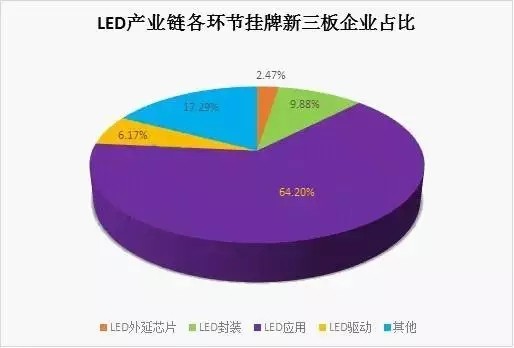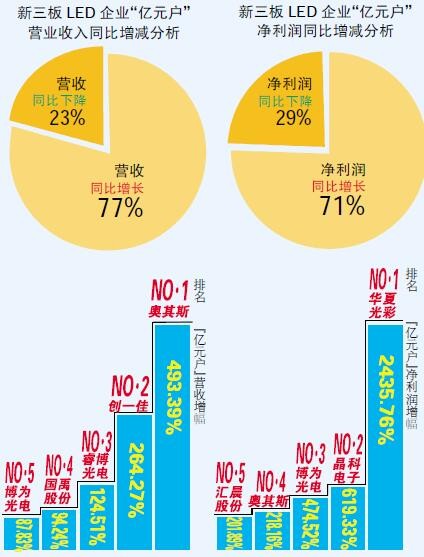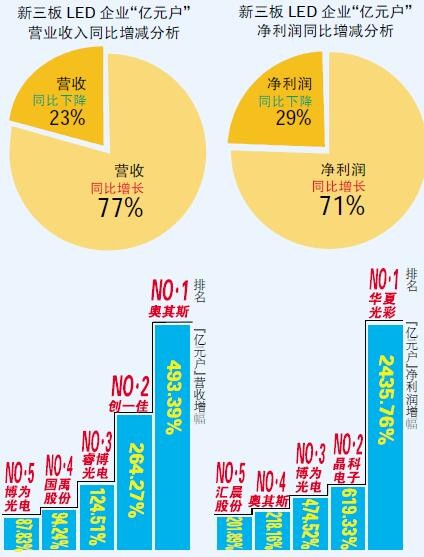The industry waited for a long time for the new three-board tiered solution, which finally made its debut on the last Friday of May. On May 27th, the National Small and Medium Enterprise Share Transfer System (hereinafter referred to as the Share Transfer System) officially issued the “Strategic Management Measures for Listed Companies of the National Small and Medium Enterprise Share Transfer System (Trial)â€. The stock transfer system said. This also means that this expansion to the country less than three years, that is, the market of more than 7,000 listed companies, divided into two, officially entered the innovation layer and the base layer and drive the double-layer era.
In the last two years, the LED industry's new three board market is strong, more and more LED companies are crowded on the road of the new three board listing. According to incomplete statistics, as of May 25, in addition to the LED companies that queued to apply for the new three boards, there were 97 LED companies that have listed the new three boards nationwide.

With the landing of the tiered system, how to squeeze into the "innovation layer" has become the focus of the new three board listed companies. According to the Eastern Fortune Choice data, according to the latest standards released by the stock transfer system, a total of 909 companies meet the criteria for entering the innovation layer, accounting for 12.29% of the total number of new three board companies. So, who has the LED industry to enter the innovation layer? Next, let us first understand the entry rules of the innovation layer under the tiered system.
Three levels of innovation + two general indicators
The Tiered Management Approach clarifies that companies that meet one of the following three criteria are expected to enter the innovation layer:
Standard 1: Net profit + return on net assets + financing amount
Continuous profit in the last two years, and the average net profit is not less than 20 million yuan;
The average return on net assets in the past two years is not less than 10%;
Standard 2: Operating income compound growth rate + operating income + equity
In the past two years, the operating income has continued to grow, and the compound growth rate is not less than 50%;
The average operating income in the last two years is not less than 40 million yuan;
The share capital is not less than 20 million yuan;
Standard 3: Market value + shareholder equity + number of market makers + number of qualified investors
The average market value of the 60 market-making transfer days that have been recently traded is not less than 600 million yuan;
At the end of the last year, the shareholders' equity is not less than 50 million yuan;
There are no fewer than 6 market makers;
Not less than 50 qualified investors;
However, it is not enough to meet the above conditions. In order to enter the new three boards, the following general conditions must be met:
The stock issuance financing has been completed in the last 12 months, and the accumulated financing amount is not less than 10 million yuan; or the actual transaction days of the last 60 transferable days accounted for not less than 50%.
In addition, entering the NEEQ also needs to meet some non-quantitative indicators, such as failure to approve violations, and the company or executives are not subject to administrative or criminal penalties.
The “100 million households†in the new three-board LED company are striving to be the innovation layer
At present, according to the Eastern Fortune Choice data, there are 426 companies that meet the standard one, 497 companies that meet the standard two, and 196 companies that meet the standard three. Many companies meet two or three standards at the same time, 23 of which meet three standards at the same time, and none of the LED companies are on the list.
Through the adjustment of this stratification plan, we can see that the income and profit scale are hard indicators and the key to entering the innovation layer. Therefore, LED companies want to enter the "innovation layer", the net profit situation is particularly important.
With the disclosure of the 2015 annual report data, in the end, the new three-board LED enterprises with revenues exceeding 100 million yuan were locked into 31, including Kang Mingsheng, Aoqisi, Chuangyijia, Jiuzhou Optoelectronics, Jingke Electronics, and Guangyu Electronics. It accounts for nearly one-third of the total number of companies.
According to statistics, in 2015, there was one new three-board LED enterprise with a revenue of more than 500 million yuan for the new three-board LED enterprise, which is Kang Mingsheng, with revenue of about 910 million yuan; and two operating incomes of 400-500 million yuan. They are Chuangyijia and Ochis respectively; there are 3 operating incomes of 3-4 billion yuan, namely Jiuzhou Optoelectronics, Yuanheng Optoelectronics and Jingke Electronics. In addition, Kang Mingsheng, as the only new three-board LED company with a business income of more than 900 million yuan, ranked second with a revenue gap of about 450 million yuan, a gap of more than half. It can be seen that “100 million households†is the top of the pyramid of the new three-board LED enterprise, and its performance can really be compared with the mainstream brands.
From the analysis of “year-on-year increase and decrease of operating incomeâ€, the national new three-board LED enterprise revenue achieved a year-on-year growth of 76%, and revenue decreased by 24% year-on-year. Among them, the top three revenue growth rates were respectively Pengyuan Optoelectronics (496.72%), Auches (493.39%), Darren (284.87%).
From the analysis of “profit rate increase and decreaseâ€, the new three-board LED companies accounted for 67% of the company's net profit growth. Among them, the top four growth rates are Huaxia Guangcai (2436%), Stellar Gaohong (2298%), Darren (1434%), and Ruiteng Technology (1035%). In the statistics of the new three-board LED enterprise “100 million householdsâ€, 71% of the companies achieved net profit growth in the past year, and the first leader was “Huaxia Guangcaiâ€.


As we all know, measuring the pros and cons of a company is an important criterion for making money. The amount of net profit depends on many factors. The more clear financial indicator is the operating income, which represents the economy formed in the daily business process of the company. The total inflow of benefits.
Xiao Bian noted that there are some high-growth companies in the New Third Board. Although there is no beautiful net profit data, its operating income also indicates that it is quite capable. In view of the hard financial indicators of operating income, the stock transfer system has also set the standard two, screening through the "competitive growth rate of operating income + operating income + equity", so that these high-growth LED companies have the opportunity to go to the forefront.
Three things that the tiered system has to know LED companies must know
Innovation floor tickets are not permanently valid
The stock transfer system will adjust the level in April every year. As long as the data disclosed in the annual report meets the innovation level standards, the basic level enterprises can smoothly “promote†and enjoy the institutional dividend of the innovation layer and relatively high liquidity. Similarly, enterprises at the innovation level will not be able to sit back and relax. Once the relevant indicators fail to meet the requirements, they will be forced to “retire†after two years.
There is no free lunch, the innovation layer is a double-edged sword
After the stratification, the attention of the market will focus more on the innovation layer. Undoubtedly, the benefits of entering the innovation layer are obvious: the increase in corporate visibility will be the preferred investment target; it may also enjoy preferential policy dividends in financing, trading, etc., the liquidity of the enterprise will be significantly improved, and the valuation will naturally rise.
But the innovation layer is also a double-edged sword. Speaking of this, we must pay attention to the elaboration of the stratification, the official words are "the share transfer system from the two aspects of service and supervision to implement two different levels of institutional arrangements", that is, the rights and obligations of the innovation level enterprises Equivalent, not only enjoys many institutional dividends, but also accepts more stringent regulatory norms in information disclosure, staffing, sales restriction management and use of raised funds. "Enterprises that fail to meet the relevant conditions will feel uncomfortable when they go to the innovation level." Yan Qiang, deputy general manager of the company, said this.
Guangzheng Hang Seng Securities also said that the innovation layer will have more stringent requirements in information disclosure, and may ask the main board listed companies to move closer.
Before and after stratification, the supervision of the stock transfer system to the main players of the New Third Board will open the “strictness†and “refinement†modes. In fact, this trend has already appeared. Recently, some brokerages revealed that the business unit of the share-transfer company issued a notice to a number of brokers on the 20th of May to conduct special statistics on the capital occupation of the listed enterprises, and requested The results will be fed back to the supervisor before 3 pm on May 23. It seems that occupying the position of the innovation layer, it is not so easy to mix the days.
The meaning of stratification: paving the way for subsequent innovation, not related to liquidity
As mentioned above, the significance of stratification is to facilitate the follow-up of public offerings, market makers (allowing non-vouchers to participate in market making), lowering the entry threshold for investors, introducing bidding transactions, and even turning the board. basis.
Layering does not bring anything directly, but there is no stratification, and everything is free.
As for the question of people's arguing that “stratification will bring about improvement in liquidity?â€, I just want to say that stratification is just a more optimized management design, and there is no dime relationship with liquidity. However, after the stratification, the regulatory layer will launch a more convenient trading system in the follow-up or for the innovation layer, and investors will increase the investment enthusiasm because of the lower quality selection cost, which may increase the liquidity of the NEEQ. In addition, policy advancement is in line with expectations, and it also helps to increase the confidence and participation of market participants and ease the pressure of liquidity tightening.
Hua Jin Securities analyst Wang Gang said that the attractiveness of stratification lies in the follow-up policy. After stratification, the innovation layer dividend is reflected in the company's information disclosure requirements in the innovation layer and the priority implementation of innovation policies. The key to the improvement of the liquidity of the New Third Board is policy innovation. The innovation policy that can significantly improve liquidity still needs to wait. In the short term, it does not have the conditions for launch. The introduction of the tiered system has played a more important role in regulating the operation of the new three boards, and is necessary to prepare for the follow-up policy.

110Kv Steel Pole,Black Metal Pole,Double Loop Angle Pole,Polygonal Steel Pole
Jiangsu Baojuhe Science and Technology Co.,Ltd. , https://www.galvanizedsteelpole.com
